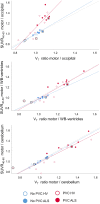Moving Toward Multicenter Therapeutic Trials in Amyotrophic Lateral Sclerosis: Feasibility of Data Pooling Using Different Translocator Protein PET Radioligands
- PMID: 32169920
- PMCID: PMC9364895
- DOI: 10.2967/jnumed.119.241059
Moving Toward Multicenter Therapeutic Trials in Amyotrophic Lateral Sclerosis: Feasibility of Data Pooling Using Different Translocator Protein PET Radioligands
Abstract
Neuroinflammation has been implicated in amyotrophic lateral sclerosis (ALS) and can be visualized using translocator protein (TSPO) radioligands. To become a reliable pharmacodynamic biomarker for ALS multicenter trials, TSPO radioligands have some challenges to overcome. We aimed to investigate whether multicenter data pooling of different TSPO tracers (11C-PBR28 and 18F-DPA714) is feasible, after validation of an established 11C-PBR28 PET pseudo reference analysis technique for 18F-DPA714. Methods: Seven ALS patients from Belgium (58.9 ± 6.7 y old, 5 men and 2 women), 8 healthy volunteers from Belgium (52.1 ± 15.2 y old, 3 men and 5 women), 7 ALS patients from the United States (53.4 ± 9.8 y old, 5 men and 2 women), and 7 healthy volunteers from the United States (54.6 ± 9.6 y old, 4 men and 3 women) from a previously published study underwent dynamic 18F-DPA714 (Leuven, Belgium) or 11C-PBR28 (Boston, Massachusetts) PET/MRI. For 18F-DPA714, maps of total volume of distribution (VT) were compared with SUV ratio (SUVR) images from 40 to 60 min after injection (SUVR40-60) calculated using the pseudo reference regions cerebellum, occipital cortex, and whole brain (WB) without ventricles. For 11C-PBR28, SUVR images from 60 to 90 min after injection using the WB without ventricles were calculated. Results: In line with previous studies, increased 18F-DPA714 uptake (17.0% ± 5.6%) in primary motor cortices was observed in ALS subjects, as measured by both VT and SUVR40-60 approaches. The highest sensitivity was found for SUVR calculated using the WB without ventricles (average cluster, 21.6% ± 0.1%). 18F-DPA714 VT ratio was highly correlated with the SUVR40-60 (r > 0.8, P < 0.001). A similar pattern of increased uptake (average cluster, 20.5% ± 0.5%) in the primary motor cortices was observed in ALS subjects for 11C-PBR28 SUVR calculated using the WB without ventricles. Analysis of the 18F-DPA714 and 11C-PBR28 data together resulted in a more extensive pattern of significantly increased glial activation bilaterally in the primary motor cortices. Conclusion: The same pseudo reference region analysis technique for 11C-PBR28 PET can be extended toward 18F-DPA714 PET. Therefore, in ALS, standardized analysis across these 2 tracers enables pooling of TSPO PET data across multiple centers and increases the power of TSPO as a biomarker for future therapeutic trials.
Keywords: 11C-PBR28; 18F-DPA714; amyotrophic lateral sclerosis; multicenter; translocator protein.
© 2020 by the Society of Nuclear Medicine and Molecular Imaging.
Figures



Similar articles
-
Integrated imaging of [11C]-PBR28 PET, MR diffusion and magnetic resonance spectroscopy 1H-MRS in amyotrophic lateral sclerosis.Neuroimage Clin. 2018 Aug 9;20:357-364. doi: 10.1016/j.nicl.2018.08.007. eCollection 2018. Neuroimage Clin. 2018. PMID: 30112276 Free PMC article.
-
TSPO Versus P2X7 as a Target for Neuroinflammation: An In Vitro and In Vivo Study.J Nucl Med. 2020 Apr;61(4):604-607. doi: 10.2967/jnumed.119.231985. Epub 2019 Sep 27. J Nucl Med. 2020. PMID: 31562223 Free PMC article.
-
Increased in vivo glial activation in patients with amyotrophic lateral sclerosis: assessed with [(11)C]-PBR28.Neuroimage Clin. 2015 Jan 19;7:409-14. doi: 10.1016/j.nicl.2015.01.009. eCollection 2015. Neuroimage Clin. 2015. PMID: 25685708 Free PMC article.
-
The potential of carbon-11 and fluorine-18 chemistry: illustration through the development of positron emission tomography radioligands targeting the translocator protein 18 kDa.J Labelled Comp Radiopharm. 2013 Mar-Apr;56(3-4):96-104. doi: 10.1002/jlcr.2992. J Labelled Comp Radiopharm. 2013. PMID: 24285315 Review.
-
Recent developments on PET radiotracers for TSPO and their applications in neuroimaging.Acta Pharm Sin B. 2021 Feb;11(2):373-393. doi: 10.1016/j.apsb.2020.08.006. Epub 2020 Aug 25. Acta Pharm Sin B. 2021. PMID: 33643818 Free PMC article. Review.
Cited by
-
Novel Tracers and Radionuclides in PET Imaging.Radiol Clin North Am. 2021 Sep;59(5):887-918. doi: 10.1016/j.rcl.2021.05.012. Radiol Clin North Am. 2021. PMID: 34392925 Free PMC article. Review.
-
Differences in Cerebral Glucose Metabolism in ALS Patients with and without C9orf72 and SOD1 Mutations.Cells. 2023 Mar 18;12(6):933. doi: 10.3390/cells12060933. Cells. 2023. PMID: 36980274 Free PMC article.
-
PET and SPECT Imaging of ALS: An Educational Review.Mol Imaging. 2023 Aug 19;2023:5864391. doi: 10.1155/2023/5864391. eCollection 2023. Mol Imaging. 2023. PMID: 37636591 Free PMC article. Review.
-
Heterogeneity of Neuroinflammatory Responses in Amyotrophic Lateral Sclerosis: A Challenge or an Opportunity?Int J Mol Sci. 2020 Oct 25;21(21):7923. doi: 10.3390/ijms21217923. Int J Mol Sci. 2020. PMID: 33113845 Free PMC article. Review.
-
Microglial Activation Visualized by [18F]-DPA714 PET Is a Potential Marker of Severity and Prognosis for Anti-LGI1 Encephalitis.Eur J Neurol. 2025 Mar;32(3):e70107. doi: 10.1111/ene.70107. Eur J Neurol. 2025. PMID: 40052391 Free PMC article.
References
Publication types
MeSH terms
Substances
Grants and funding
LinkOut - more resources
Full Text Sources
Medical
Miscellaneous
